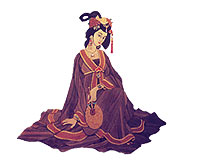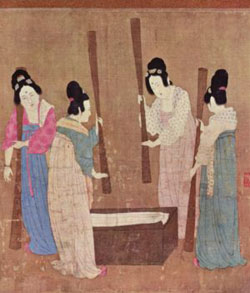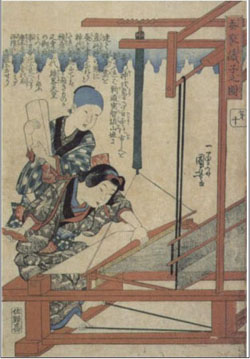|

The History
of Silk
The
history of silk begins,
according to the
writings of Confucius
and Chinese
tradition in the 27th century BC
when a silk worm's cocoon fell into the tea cup of the Empress Leizu.
Wanting to extract it from her drink, the young girl began to
unroll
the thread of the cocoon. She then had the idea to weave it.
Having
observed the life of the silk worm on the recommendation of her
husband, the Yellow
Emperor, she began to instruct her entourage in the art of
raising silk worms, sericulture.
From this point on, the girl became the goddess of silk in Chinese
mythology.
The
Emperor
saw the fabric as magical and reserved its wear for his own
family and important persons of the court. As techniques for
nurturing
the silkwormsimproved,
silk became more common. But the Chinese
realized the value of the material and began to trade silk in Persia
and Mesopotamia.

The
silk
industry was shrouded in secrecy as
the Chinese sought to keep the
secret of silk away from the rest of the world. Demand for
the lustrous
fabric created a route to China that became known as the "Silk Road".
The Chinese guarded the secret of silk production carefully, searching
travelers at the border. Anyone caught smuggling silkworms,
cocoons or
eggs was summarily executed.
Silk
would
eventually leave China in the hair of a princess
promised to a prince of Khotan. This probably occurred in the
early 1st
century AD. The princess, refusing to go without the fabric
she loved,
would finally break the imperial
ban on silk worm exportation.
Toward
the middle of the 1st century AD, the Byzantine emperor
ordered
two christian monks
who were traveling to China to smuggle some moth eggs when they
returned. The monks concealed the precious eggs in bamboo
walking
staffs. The church
established a silk industry as an imperial
monopoly.
The
use of silk
was confined to China until the Silk Road
opened at some point during the latter half of the first millennium BC.
China maintained its virtual monopoly over silk for
another thousand years. Not confined to clothing,
silk was also used for a number of other applications, including
writing, and the colour of silk worn was an important indicator of
social class
during the Tang
Dynasty.
managed to obtain brought silk production to Silk cultivation spread to
Japan
in around 300 AD, and by 522, the Byzantinessilkworm
eggs and were able to begin silkworm cultivation. The Arabs also
began to manufacture silk during this same time. As a result
of the
spread of sericulture,
Chinese silk exports became less important, although they still
maintained dominance over the luxury silk
market. The crusadesWestern
Europe, in particular to many Italian
states, which saw an economic boom exporting silk to the rest of
Europe. Changes in manufacturing techniques also began to
take place
during the Middle
Ages, with devices such as the spinning wheel
first appearing. During the 16th century, France
joined Italy in developing a successful silk trade, though the efforts
of most other nations to develop a silk industry of their own were
unsuccessful.

The
Industrial
Revolution changed much of Europe’s silk
industry. Due to innovations in spinning cotton,
it became much cheaper to manufacture and therefore caused more
expensive silk production to become less mainstream. New weaving
technologies, however, increased the efficiency of production. Among
these was the Jacquard
loom, a precursor to modern computers,
developed for silk embroidery. An epidemic
of several silkworm diseases caused production to fall, especially in
France, where the industry never recovered. In the 20th
century, Japan
and China regained their earlier role in silk production, and China is
now once again the world’s largest producer of silk.
The rise
of
new fabrics such as nylon
reduced the prevalence of silk throughout the world, and silk is now
once again a somewhat rare luxury good.
|


|